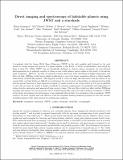| dc.contributor.author | Soummer, Rémi | |
| dc.contributor.author | Valenti, Jeff | |
| dc.contributor.author | Brown, Robert A. | |
| dc.contributor.author | Tumlinson, Jason | |
| dc.contributor.author | Postman, Marc | |
| dc.contributor.author | Mountain, Matt | |
| dc.contributor.author | Seager, Sara | |
| dc.contributor.author | Cash, Webster | |
| dc.contributor.author | Jordan, Ian | |
| dc.contributor.author | Glassman, Tiffany | |
| dc.contributor.author | Pueyo, Laurent | |
| dc.contributor.author | Roberge, Aki | |
| dc.date.accessioned | 2011-03-10T18:58:51Z | |
| dc.date.available | 2011-03-10T18:58:51Z | |
| dc.date.issued | 2010-06 | |
| dc.identifier.issn | 0277-786X | |
| dc.identifier.uri | http://hdl.handle.net/1721.1/61646 | |
| dc.description.abstract | A starshade with the James Webb Space Telescope (JWST) is the only possible path forward in the next decade to obtain images and spectra of a planet similar to the Earth, to study its habitability, and search for signs of alien life. While JWST was not specifically designed to observe using a starshade, its near-infrared instrumentation is in principle capable of doing so and could achieve major results in the study of terrestrial mass exoplanets. However, because of technical reasons associated with broadband starlight suppression and filter red-leak, NIRSpec would need a slight modification to one of its target acquisition filters to enable feasible observations of Earth-like planets. This upgrade would 1) retire the high risk associated with the effects of the current filter red leak which are difficult to model given the current state of knowledge on instrument stray light and line spread function at large separation angles, 2) enable access to the oxygen band at 0.76 μm in addition to the 1.26 μm band, 3) enable a smaller starshade by relaxing requirements on bandwidth and suppression 4) reduce detector saturation and associated long recovery times. The new filter would not affect neither NIRSpecs scientific performance nor its operations, but it would dramatically reduce the risk of adding a starshade to JWST in the future and enhance the performance of any starshade that is built. In combination with a starshade, JWST could be the most capable and cost effective of all the exoplanet hunting missions proposed for the next decade, including purpose built observatories for medium-size missions. | en_US |
| dc.language.iso | en_US | |
| dc.publisher | Society of Photo-optical Instrumentation Engineers | en_US |
| dc.relation.isversionof | http://dx.doi.org/10.1117/12.858347 | en_US |
| dc.rights | Article is made available in accordance with the publisher's policy and may be subject to US copyright law. Please refer to the publisher's site for terms of use. | en_US |
| dc.source | SPIE | en_US |
| dc.title | Direct imaging and spectroscopy of habitable planets using JWST and a starshade | en_US |
| dc.type | Article | en_US |
| dc.identifier.citation | Soummer, Remi et al. “Direct imaging and spectroscopy of habitable planets using JWST and a starshade.” Space Telescopes and Instrumentation 2010: Optical, Infrared, and Millimeter Wave. Ed. Jacobus M. Oschmann et al. San Diego, California, USA: SPIE, 2010. 77312I-15. ©2010 SPIE. | en_US |
| dc.contributor.department | Massachusetts Institute of Technology. Department of Earth, Atmospheric, and Planetary Sciences | en_US |
| dc.contributor.approver | Seager, Sara | |
| dc.contributor.mitauthor | Seager, Sara | |
| dc.relation.journal | Proceedings of SPIE--the International Society for Optical Engineering ; v. 7731 | en_US |
| dc.eprint.version | Final published version | en_US |
| dc.type.uri | http://purl.org/eprint/type/ConferencePaper | en_US |
| dspace.orderedauthors | Soummer, Remi; Valenti, Jeff; Brown, Robert A.; Seager, Sara; Tumlinson, Jason; Cash, Webster; Jordan, Ian; Postman, Marc; Mountain, Matt; Glassman, Tiffany; Pueyo, Laurent; Roberge, Aki | en |
| dc.identifier.orcid | https://orcid.org/0000-0002-6892-6948 | |
| mit.license | PUBLISHER_POLICY | en_US |
| mit.metadata.status | Complete | |
